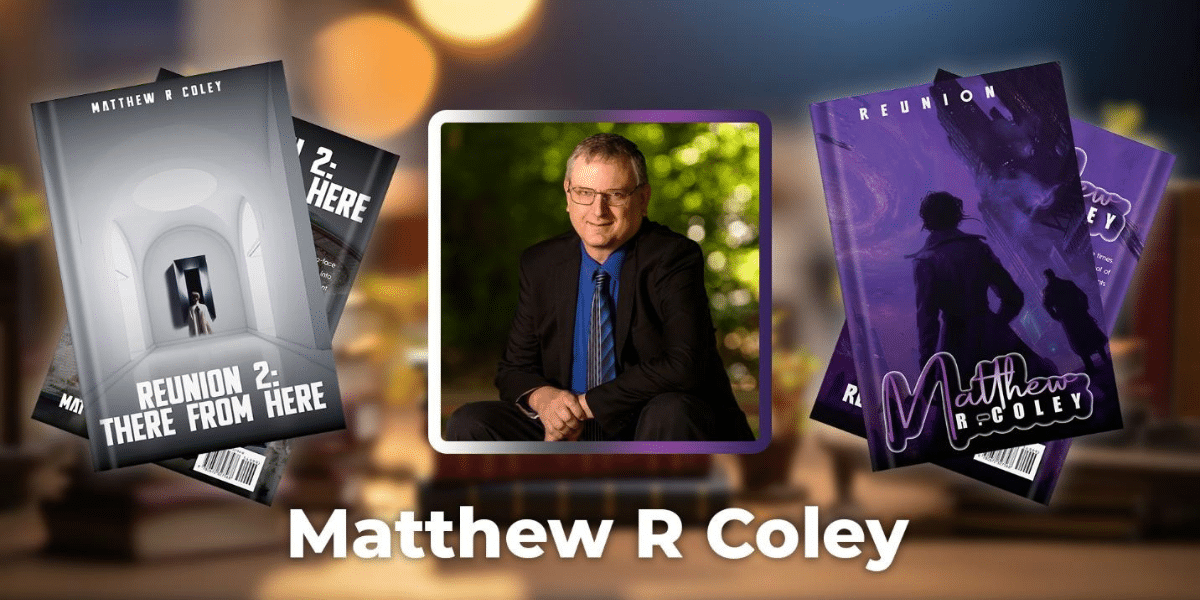By: Seraphina Quinn
Matt Coley’s life effortlessly blends the ordinary with the extraordinary. As a tech enthusiast and visionary, he has always seen beyond the surface, merging the real and the surreal. From programming games at a Sears store as a kid to selling computers before most teens get their licenses, his journey has been anything but typical. But what truly stands out isn’t just his early achievements; it’s the profound intensity of his experiences with life, death, and the unknown. His book, There from Here, is far more than a sci-fi adventure about aliens and spaceships—it’s a deeply personal reflection of his life, dreams, and the moments where fate was both a blessing and a curse.
One of the foundational moments in the book involves a family abducted by aliens. It sounds like pure fantasy, right? Except Coley vividly recalls his mother’s face in a dream so detailed it left him questioning whether it was truly just a dream. This haunting dream has stayed with him since his childhood, hence making him believe that a clone of his mother was sent back to live with the family. At first glance, it seems like a far-fetched plot twist—but for Coley, it was the spark that ignited his writing journey, blurring the line between fiction and reality in an unsettling way.
What’s fascinating about There from Here isn’t just the alien abductions and otherworldly beings—it’s the juxtaposition of these fantastical elements with the mundane. Chris, a mathematical prodigy at the age of six, doesn’t just grapple with the mysteries of the universe; he also faces bullying at school. Or Sally, a mother who confronts both the impossibility of alien cloning and the very real human fear of losing her child. There’s an intimacy to the struggles of the characters, one that feels eerily familiar despite the alien setting.
This is what makes Coley’s work so gripping. He takes the things that scare us—family, identity, survival—and twists them into scenarios that make us question what we believe about the nature of life. The premise that an alien race has been covertly aiding humanity for centuries while abducting and experimenting on people feels like a well-worn trope in science fiction. But his delivery gives it a refreshing plausibility. After all, he’s survived enough near-death experiences to make even skeptics reconsider the boundaries between reality and the unknown.
His story isn’t just about supernatural saviors or scientific experimentation—it’s about resilience. He recounts a real-life brush with death when his car spun out on black ice, narrowly avoiding a fatal collision with a semi-truck. “We all yelled goodbye at the same time,” Coley recalls, but somehow, they survived. Moments like this inform his storytelling, making the line between luck, fate, and something else less clear. These moments anchor his fiction in something deeply personal and hauntingly possible.
One could argue that There from Here stands out not because of its extraterrestrial elements but because it turns these elements into mirrors of our own lives. In some sense, we’re all navigating strange, uncertain spaces—whether it’s a traffic accident or a sudden life-altering event that throws us into the unknown. Coley’s characters, like many of us, are figuring it out as they go along. And that’s the real beauty of his work.
Even more remarkable is the almost eerie realism of his writing. Despite the alien landscapes and complex interstellar politics, Coley never loses sight of the core human emotions driving his characters. Chris’ mathematical genius, for example, isn’t just a plot device; it mirrors Coley’s own experience as a child prodigy who nearly skipped ahead in school before his mother intervened to protect him from potential bullying. It’s in moments like these that readers are drawn in, not because of flashy sci-fi battles but because of the very real, relatable emotions simmering just below the surface.
It’s this combination of science fiction grounded in human emotion that keeps readers returning to There from Here. While other books focus on grand battles or world-ending stakes, Coley keeps the stakes personal. His story is as much about a mother fighting for her family as it is about extraterrestrial saviors trying to prevent their civilization’s downfall. There’s a duality to it—a merging of the ordinary with the extraordinary—that keeps readers guessing.
What’s surprising isn’t just the combination of sci-fi elements and familial drama; it’s how Coley crafts a narrative where the aliens aren’t hostile invaders but complex beings struggling with their own existential crises. The Mygas, an ancient alien race central to the plot, aren’t depicted as conquerors but as reluctant saviors, manipulating DNA to prevent their extinction. The twist? They’ve been quietly influencing humanity for centuries, their presence hidden in the shadows of human history. In a genre obsessed with large-scale battles and dystopian futures, Coley offers something different: a meditation on survival, family, and the choices we make when confronted with the unknown.
And that’s the beauty of his writing. He makes us question the very foundations of what we think we know. His tales may seem like fiction, but they’re rooted in his real-life experiences—whether it’s narrowly escaping death, challenging the boundaries of the human intellect, or grappling with the strange, unexplained phenomena that have colored his life since childhood. In the end, There from Here isn’t just about aliens or advanced technology—it’s about humanity. Our fears, hope, and unending quest for understanding in a universe is far stranger than we could ever imagine.
Is it any wonder that readers find themselves unable to put it down?
In a world that increasingly feels like science fiction itself, Matt Coley’s There from Here offers a refreshingly introspective take on the genre—one that challenges our assumptions, tugs at our emotions, and leaves us looking at the sky just a little differently.
Published by: Nelly Chavez

















